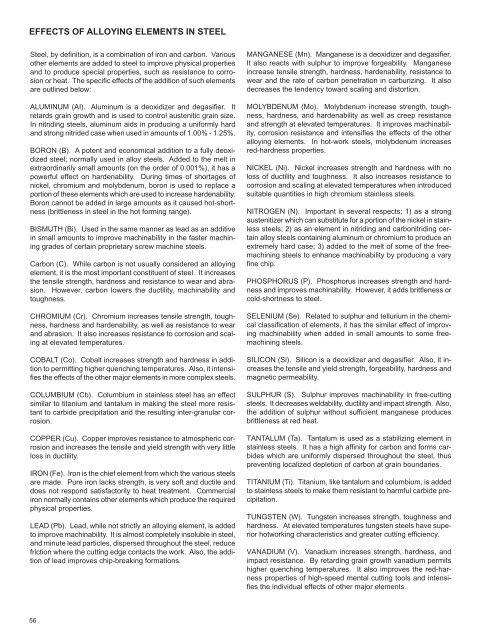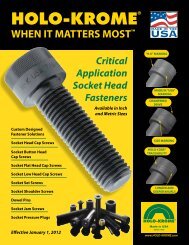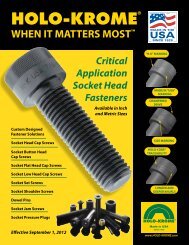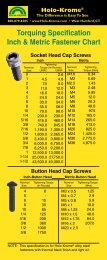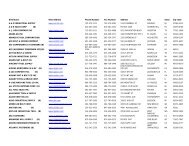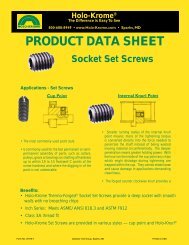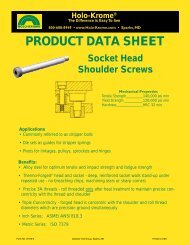Consolidated Tech Man - Holo-Krome
Consolidated Tech Man - Holo-Krome
Consolidated Tech Man - Holo-Krome
You also want an ePaper? Increase the reach of your titles
YUMPU automatically turns print PDFs into web optimized ePapers that Google loves.
EFFECTS OF ALLOYING ELEMENTS IN STEEL<br />
Steel, by definition, is a combination of iron and carbon. Various<br />
other elements are added to steel to improve physical properties<br />
and to produce special properties, such as resistance to corrosion<br />
or heat. The specific effects of the addition of such elements<br />
are outlined below:<br />
ALUMINUM (AI). Aluminum is a deoxidizer and degasifier. It<br />
retards grain growth and is used to control austenitic grain size.<br />
In nitriding steels, aluminum aids in producing a uniformly hard<br />
and strong nitrided case when used in amounts of 1.00% - 1.25%.<br />
BORON (B). A potent and economical addition to a fully deoxidized<br />
steel; normally used in alloy steels. Added to the melt in<br />
extraordinarily small amounts (on the order of 0.001%), it has a<br />
powerful effect on hardenability. During times of shortages of<br />
nickel, chromium and molybdenum, boron is used to replace a<br />
portion of these elements which are used to increase hardenability.<br />
Boron cannot be added in large amounts as it caused hot-shortness<br />
(brittleness in steel in the hot forming range).<br />
BISMUTH (Bi). Used in the same manner as lead as an additive<br />
in small amounts to improve machinability in the faster machining<br />
grades of certain proprietary screw machine steels.<br />
Carbon (C). While carbon is not usually considered an alloying<br />
element, it is the most important constituent of steel. It increases<br />
the tensile strength, hardness and resistance to wear and abrasion.<br />
However, carbon lowers the ductility, machinability and<br />
toughness.<br />
CHROMIUM (Cr). Chromium increases tensile strength, toughness,<br />
hardness and hardenability, as well as resistance to wear<br />
and abrasion. It also increases resistance to corrosion and scaling<br />
at elevated temperatures.<br />
COBALT (Co). Cobalt increases strength and hardness in addition<br />
to permitting higher quenching temperatures. Also, it intensifies<br />
the effects of the other major elements in more complex steels.<br />
COLUMBIUM (Cb). Columbium in stainless steel has an effect<br />
similar to titanium and tantalum in making the steel more resistant<br />
to carbide precipitation and the resulting inter-granular corrosion.<br />
COPPER (Cu). Copper improves resistance to atmospheric corrosion<br />
and increases the tensile and yield strength with very little<br />
loss in ductility.<br />
IRON (Fe). Iron is the chief element from which the various steels<br />
are made. Pure iron lacks strength, is very soft and ductile and<br />
does not respond satisfactorily to heat treatment. Commercial<br />
iron normally contains other elements which produce the required<br />
physical properties.<br />
LEAD (Pb). Lead, while not strictly an alloying element, is added<br />
to improve machinability. It is almost completely insoluble in steel,<br />
and minute lead particles, dispersed throughout the steel, reduce<br />
friction where the cutting edge contacts the work. Also, the addition<br />
of lead improves chip-breaking formations.<br />
56<br />
MANGANESE (Mn). <strong>Man</strong>ganese is a deoxidizer and degasifier.<br />
It also reacts with sulphur to improve forgeability. <strong>Man</strong>ganese<br />
increase tensile strength, hardness, hardenability, resistance to<br />
wear and the rate of carbon penetration in carburizing. It also<br />
decreases the tendency toward scaling and distortion.<br />
MOLYBDENUM (Mo). Molybdenum increase strength, toughness,<br />
hardness, and hardenability as well as creep resistance<br />
and strength at elevated temperatures. It improves machinability,<br />
corrosion resistance and intensifies the effects of the other<br />
alloying elements. In hot-work steels, molybdenum increases<br />
red-hardness properties.<br />
NICKEL (Ni). Nickel increases strength and hardness with no<br />
loss of ductility and toughness. It also increases resistance to<br />
corrosion and scaling at elevated temperatures when introduced<br />
suitable quantities in high chromium stainless steels.<br />
NITROGEN (N). Important in several respects; 1) as a strong<br />
austenitizer which can substitute for a portion of the nickel in stainless<br />
steels; 2) as an element in nitriding and carbonitriding certain<br />
alloy steels containing aluminum or chromium to produce an<br />
extremely hard case; 3) added to the melt of some of the freemachining<br />
steels to enhance machinability by producing a vary<br />
fine chip.<br />
PHOSPHORUS (P). Phosphorus increases strength and hardness<br />
and improves machinability. However, it adds brittleness or<br />
cold-shortness to steel.<br />
SELENIUM (Se). Related to sulphur and tellurium in the chemical<br />
classification of elements, it has the similar effect of improving<br />
machinability when added in small amounts to some freemachining<br />
steels.<br />
SILICON (Si). Silicon is a deoxidizer and degasifier. Also, it increases<br />
the tensile and yield strength, forgeability, hardness and<br />
magnetic permeability.<br />
SULPHUR (S). Sulphur improves machinability in free-cutting<br />
steels. It decreases weldability, ductility and impact strength. Also,<br />
the addition of sulphur without sufficient manganese produces<br />
brittleness at red heat.<br />
TANTALUM (Ta). Tantalum is used as a stabilizing element in<br />
stainless steels. It has a high affinity for carbon and forms carbides<br />
which are uniformly dispersed throughout the steel, thus<br />
preventing localized depletion of carbon at grain boundaries.<br />
TITANIUM (Ti). Titanium, like tantalum and columbium, is added<br />
to stainless steels to make them resistant to harmful carbide precipitation.<br />
TUNGSTEN (W). Tungsten increases strength, toughness and<br />
hardness. At elevated temperatures tungsten steels have superior<br />
hotworking characteristics and greater cutting efficiency.<br />
VANADIUM (V). Vanadium increases strength, hardness, and<br />
impact resistance. By retarding grain growth vanadium permits<br />
higher quenching temperatures. It also improves the red-harness<br />
properties of high-speed mental cutting tools and intensifies<br />
the individual effects of other major elements.


